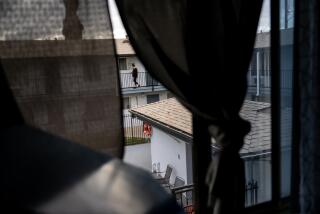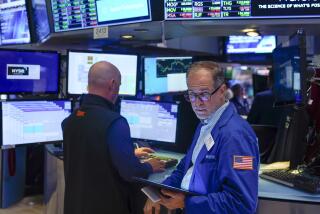Lindner Dividend Is Struggling to Regain Its Winning Ways
- Share via
This occasional column will evaluate funds that have stumbled and will consider the hardest question most investors face: whether to stay or go.
*
In the winter issue of its newsletter last year, the Lindner family of funds boasted:
Lindner Dividend “Tops Morningstar National Rankings.”
“When Morningstar reported on the nation’s highest . . . yielding hybrid funds as of November 30, 1998, the Lindner Dividend Fund led all funds in Morningstar’s national database at 8.29%.”
True. But yield is only part of the story.
It’s one of two components that make up a fund’s “total return.” The other is capital appreciation. And missing from the item was any mention of the profound difficulties Dividend was having in this area.
Difficulties that Michael Diehl is all too familiar with.
The 48-year-old Glendale resident has owned shares of the $884-million “hybrid fund” (meaning it invests in a mix of stocks, bonds and other types of securities) since late 1993.
And in each of the five years since, Dividend has finished in the bottom half or quarter of its peers when it comes to total returns.
Says Diehl: “It’s become a laughingstock.”
The Fund: Lindner Dividend, based in St. Louis.
The Problem: If all you care about is current income, there might not be a problem.
Lindner Dividend remains the highest-yielding domestic hybrid fund around, with an annualized yield of 8.9%, according to fund tracker Morningstar.
But if, like most investors, you also care whether your investments are rising in value--and rising considerably over time--then there’s something to worry about.
Of the 690 domestic hybrid funds that Morningstar tracked in 1998, Lindner Dividend wound up finishing 677th, based on its disappointing 1998 total return of --4.01%. In other words, the fund’s high yield was more than offset by a drop in the share price.
Over the past three years through April 30, Dividend has delivered an annualized total return of just 4.4%, according to Morningstar. That’s about a third of the return of the typical domestic hybrid fund, and worse than the average annual return of a typical short-term bond fund.
How bad is it?
Based on year-to-date, one-year, three-year and five-year total returns, the fund ranks in the bottom 2% of its category peers, Morningstar figures show. Even on a 10-year and 15-year basis, at least 80% of Dividend’s peers have returned more.
The fund has stressed that current income, not capital appreciation, is its first priority. But even Eric Ryback, the longtime manager of this and all other Lindner funds, acknowledges: “People are getting tired. The income is great, but they’re uncomfortable with the lagging returns.”
What Went Wrong: Six years ago, when Diehl jumped in, Lindner Dividend was considered one of the funds to own.
With its eclectic mix of common stocks, preferred stocks, convertible securities and high-yield bonds, manager Ryback somehow managed to deliver returns that exceeded the Standard & Poor’s 500 index of blue-chip stocks (at least in 1992 and 1993) but with nowhere near the risk.
Then, in 1994, the wheels seemed to come off this fund. There were a myriad of reasons behind it.
For starters, there was the issue of time--the fact that Ryback may have had too little of it.
In 1991, when Dividend was on fire, Ryback was overseeing just two funds: Dividend and Lindner Growth. By 1995, Lindner had launched four additional funds, all of which he helped run.
“We were stretched thin,” says Ryback. “I’d be the first to admit that.”
Next, there was the issue of money: There may have been too much of it coming in. Like many once “hot” funds that have since cooled, Lindner may have seen too much new cash come in too fast.
In 1990, its assets stood at $150 million. It took less than five years thereafter for Dividend to grow into a $2-billion fund.
What’s more, all of this took place just as the wind that was at Dividend’s back began to disappear.
Since its founding in 1976, Dividend has always been a traditional “value”-oriented fund. In other words, it seeks out only the most beaten-down and overlooked stocks, while ignoring volatile shares of growth companies. In fact, until recently, the fund focused on stocks with price/earnings ratios in the single digits, which limited it to slow-growth sectors like energy, utilities and gold.
Unfortunately, the market turned against these sectors in recent years, favoring instead the large growth stocks that Ryback and other value managers can’t own.
What Really Went Wrong: A string of bad decisions starting in 1994 may have played a bigger role in the fund’s downturn.
Lindner Dividend is no typical hybrid fund. Whereas your average hybrid fund invests in just common stocks and high-quality bonds, Dividend has traditionally invested in an eclectic group of assets: common stock, preferred stock, convertible preferred stock, convertible bonds and high-yield debt.
These have helped Ryback deliver above-average yield and, at times, stock-fund-like returns without stock-fund-like volatility.
Ryback has a rule of thumb when it comes to these different asset classes.
When interest rates are rising, he has traditionally lowered the fund’s stake in common stocks while increasing its stake in higher-yielding corporate debt and convertible bonds.
Which is what he did in 1994, when rates began to shoot up.
Unfortunately, Dividend’s low exposure to common stocks leading into the following year made it tough for the fund to compete with its peers. In 1995, the S&P; 500 soared 37.6%. Dividend gained 21.6%.
The following year, 1996, Dividend raised its equity stake. But it didn’t help much, because Ryback did so by increasing the fund’s stake in utility stocks. (He did so in hopes of capturing their relatively high dividend yields.) Utilities were relative flops in 1996.
In 1997, Ryback tried something else. He started shifting more money into convertible preferred shares, because “they had very attractive yields, and I thought they could provide a growth kicker.” Convertibles are supposed to track, to some degree, the moves in the underlying common stock of the companies that issue them.
Beginning in mid-1997 and continuing through 1998, Ryback said, as much as 35% of the fund was in convertible preferreds.
This, too, failed.
In fact, “that’s what really hurt me last year,” Ryback says. “Traditionally, these convertibles hold up very well. But they didn’t.”
Meanwhile, Dividend reduced its common stocks last year and raised its stake in low-quality junk and convertible bonds--just in time for the Federal Reserve to cut short-term interest rates, sending stocks surging by year’s end. The move to lower-quality junk bonds also took place just as the global flight to quality punished all but the highest-quality bonds.
“Obviously, these have been extremely difficult times,” Ryback said.
The Plan to Turn Things Around: Big changes have already been announced at the Lindner funds. For starters, the management structure of all Lindner funds has been overhauled.
Overseeing all funds--including Dividend--is now a three-member investment committee on which Ryback holds just one vote. Under the old system, Ryback managed or co-managed all the funds himself.
This should free up Ryback and others to concentrate more on Dividend, Lindner officials say.
Also, Lindner Dividend will pay greater attention to total returns--not just its payouts, says Mark Finn, the newly named vice chairman of Lindner Asset Management and one of the members of the new investment committee.
Ryback says Dividend will continue to yield far more than the average domestic hybrid fund. But going forward, the yield may drop down from the 8% level to 6%.
This, in addition to recent adjustments to the Lindner stock valuation model, should allow the fund to begin investing in slightly larger, more liquid issues--which the market has favored recently--and in slightly higher-quality bonds, Finn says.
Can This Fund Be Saved? Absolutely. The question is, is it worth sticking around to find out?
Lindner seems to have begun to address some of Dividend’s problems. For instance, the new team has installed a quantitative computer model that will help it identify undervalued securities.
The system will also keep tabs on whether the fund, in the name of finding cheap stocks, is concentrating too much of its assets in a single, vulnerable sector.
Also, stock market leadership has recently broadened to include some of the commodity and industrial cyclical names that Dividend and other value funds own.
This would, then, seem like a bad time to give up on this value-oriented fund. Still, there are a number of concerns going forward, analysts say.
For starters, with investors redeeming so much money from the fund--Dividend suffered net redemptions in 1996, 1997, 1998 and the first quarter of 1999--some fear that this will make it difficult for the fund to post solid and consistent short-term performance numbers.
Also, with so many changes taking place, such as the new investment committee approach, you may have to regard this as a completely new fund, an untested one at that, says Russel Kinnel, equity editor for Morningstar Mutual Funds.
Of course, one could argue that this isn’t a new fund, because Ryback will continue to help run it. But if that’s the case, Kinnel asks: “Wasn’t he the one who made all those mistakes?
“So much is wrong with this fund, its record is so bad, I don’t see any compelling reason to stick around,” Kinnel says.
There is still the issue of Lindner Dividend’s better-than-average yield. An investor solely or primarily interested in current income may want to stick it out. The fund yields more than three times as much as the average domestic hybrid fund.
But if we are to believe what the company says, the yield advantage may drop somewhat going forward, which would make Dividend less special in this sense.
“And if you’re looking for a conservative hybrid fund with a good long-term track record, there are plenty out there,” Kinnel argues.
*
Times staff writer Paul J. Lim can be reached at [email protected].
(BEGIN TEXT OF INFOBOX / INFOGRAPHIC)
Good Income, Bad Returns
Among domestic hybrid funds, those that invest in a mix of stocks and bonds, Lindner Dividend pays out the most in current income. But yield is just one of two components that make up a fund’s total return.
The other is capital appreciation. And the fund is having problems in this area. After five straight years of poor performance, it is among the worst in its category in terms of total return.
*--*
1-year 3-year 5-year tota annual annual return return return Lindner Dividend 9.8% 4.4% 8.0% Avg. Domestic Hybrid Fund 7.5 13.1 13.2 S&P; 500 21.8 29.1 26.8
*--*
Note: Return figures as of April 30
Source: Morningstar
More to Read
Inside the business of entertainment
The Wide Shot brings you news, analysis and insights on everything from streaming wars to production — and what it all means for the future.
You may occasionally receive promotional content from the Los Angeles Times.










